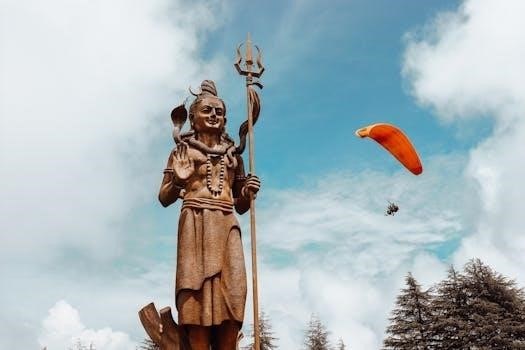shiva astothara satha namavali in telugu pdf
The Shiva Ashtottara Sata Namavali is a sacred hymn comprising 108 names of Lord Shiva. This revered collection is used in worship to invoke blessings and divine connection, often recited by devotees.
Significance of 108 Names of Lord Shiva
The number 108 holds immense significance in Hinduism, representing wholeness and cosmic order. Each of the 108 names in the Shiva Ashtottara Sata Namavali describes a unique attribute of Lord Shiva, showcasing his diverse forms and powers. Chanting these names is believed to purify the mind, instill devotion, and bring spiritual benefits. The repetition of these names is a powerful way for devotees to connect with the divine essence of Lord Shiva. It is considered a sacred practice that helps to achieve inner peace, divine blessings and spiritual growth. This sacred text is a significant part of Shiva worship.

Shiva Ashtottara Sata Namavali in Telugu
The Shiva Ashtottara Sata Namavali is available in Telugu, catering to Telugu-speaking devotees. This version allows for a deeper connection through familiar language.
Availability of Telugu PDF Downloads
Numerous websites offer the Shiva Ashtottara Sata Namavali in Telugu PDF format, making it easily accessible for devotees. These downloadable files provide a convenient way to access and use the sacred text for personal worship and recitation. Several sources provide this resource including Vaidika Vignanam, which offers a large collection of spiritual literature in various Indian languages, including Telugu, with PDF versions of the Namavali. These PDFs are typically formatted for easy reading and printing. The availability online ensures that this devotional resource is widespread.
Different Versions of the Namavali
While the core of the Shiva Ashtottara Sata Namavali remains consistent, there might be slight variations in different versions available in Telugu PDF format. These variations could stem from different lineages or interpretations of the names. Some versions might include additional verses or slight differences in the order of names. The language can also vary, from pure Telugu to a more Sanskritized form of Telugu. It’s advisable for users to choose a version that aligns with their personal understanding and practice. The differences are usually minor and do not affect the overall spiritual essence of the Namavali.

Reciting the Shiva Ashtottara Sata Namavali
Reciting the 108 names is a powerful form of worship. It is believed to bring peace, spiritual growth, and divine blessings to the devotee.
Benefits of Chanting the Names
Chanting the Shiva Ashtottara Sata Namavali is believed to bestow numerous spiritual and worldly benefits. Devotees believe it brings inner peace, reduces stress, and fosters a closer connection with Lord Shiva. Regular recitation is thought to purify the mind, enhance focus, and remove obstacles from one’s path. It’s also considered a powerful way to gain blessings, good health, and prosperity. The practice is seen as a means to cultivate devotion, and spiritual growth, and ultimately, attain liberation. The act of repeating the names is itself a form of meditation, aiding in mental clarity and emotional stability.
Proper Way to Recite
To properly recite the Shiva Ashtottara Sata Namavali, one should find a clean and quiet space, preferably in the morning or evening. Begin with a prayer to Lord Shiva, expressing your devotion. Pronounce each name clearly and with respect, focusing on its meaning. You can use a rosary or mala to keep track of the repetitions. Maintain a steady rhythm and pace, avoiding haste. Reciting with a calm and focused mind is essential for maximum spiritual benefit. Some prefer to chant aloud, while others find silent recitation more conducive to meditation. The key is sincerity and devotion.
Content of the Shiva Ashtottara Sata Namavali
The Namavali contains 108 names, each describing a unique aspect of Lord Shiva. These names reflect his power, compassion, and various divine attributes.
Examples of Names and Their Meanings
Within the Shiva Ashtottara Sata Namavali, each name holds a profound meaning, revealing different facets of Lord Shiva’s divine nature. For example, ‘Shiva’ signifies auspiciousness, while ‘Maheshwara’ denotes the great lord. ‘Shambhu’ refers to the source of joy and benevolence, and ‘Pinaki’ is the wielder of the bow. ‘Shashishekhara’ indicates he who adorns the moon on his head, and ‘Neelalohita’ describes his blue and red complexion. ‘Kapardi’ means one with matted hair, and ‘Virupaksha’ signifies one with unique eyes. These names, among others, paint a comprehensive picture of Shiva’s divine persona, each carrying deep spiritual significance for devotees.
Devotional Aspect of Each Name
Each name within the Shiva Ashtottara Sata Namavali is imbued with a deep devotional essence, serving as a powerful tool for connecting with Lord Shiva. Reciting these names with sincerity and devotion allows devotees to immerse themselves in the divine qualities of Shiva. The repetition of each name fosters a sense of reverence and contemplation, drawing the practitioner closer to the deity. This devotional practice is not merely about uttering words but about engaging the heart and mind in a profound spiritual communion with Lord Shiva. Each name is a key to unlock a specific aspect of his divine presence and grace, enriching the devotee’s spiritual journey.

Where to Find Shiva Ashtottara Sata Namavali
The Shiva Ashtottara Sata Namavali is readily available on various online platforms. Many websites offer downloadable PDF versions, often in multiple languages, including Telugu.
Online Resources and Websites
Numerous websites provide access to the Shiva Ashtottara Sata Namavali, often in Telugu PDF format. These resources include platforms dedicated to spiritual and devotional literature, such as Vaidika Vignanam, which offers the Namavali in multiple Indian languages. Additionally, other online libraries and blogs also host this sacred text. Many sites provide options to download the PDF files directly. Some websites also feature the text online, allowing for easy reading and reference. Furthermore, YouTube channels offer audio recitations of the Namavali, which can be useful for learning the correct pronunciation and rhythm. These digital resources make the Shiva Ashtottara Sata Namavali widely accessible to devotees globally.
PDF Downloads and Formats
The Shiva Ashtottara Sata Namavali is widely available in PDF format, catering to devotees who prefer digital access. These PDF files often present the text in clear Telugu script, ensuring readability for those familiar with the language. Many websites offer free downloads of the Namavali, making it easily accessible to a wide audience. The PDF format is convenient for saving, sharing, and printing, allowing devotees to use the Namavali in various settings. Additionally, some PDF versions may include transliterations in other scripts or English translations, aiding understanding and pronunciation for non-Telugu speakers. This digital format allows for easy use during personal worship and group recitations.

Other Relevant Information
The Shiva Ashtottara Sata Namavali is deeply connected to Shiva worship and is often used alongside other mantras and stotras. It is a powerful tool for devotion.
Connection to Shiva Worship
The Shiva Ashtottara Sata Namavali holds a significant place in Shiva worship, serving as a primary method for devotees to connect with Lord Shiva. Reciting these 108 names is considered a sacred act, deeply rooted in Hindu traditions. Each name reflects a different facet of Shiva’s divine nature and attributes, allowing devotees to focus on specific aspects of the deity during their prayers. This practice is believed to invoke Shiva’s blessings, promote spiritual growth, and bring peace and prosperity to the practitioner. The namavali is often chanted during pujas, rituals, and daily prayers as a means of expressing devotion and seeking divine grace. It is a cherished and time-honored tradition among Shiva followers.
Related Mantras and Stotras
Beyond the Shiva Ashtottara Sata Namavali, several other mantras and stotras are closely associated with Lord Shiva, enhancing the depth of devotion. The powerful “Om Namah Shivaya” mantra is a fundamental chant used for meditation and prayer. The Shiva Tandava Stotram, a poetic hymn, celebrates Shiva’s cosmic dance. The Lingashtakam praises the form of the lingam, a symbol of Shiva. Additionally, various shlokas and bhajans dedicated to Shiva exist in Telugu and other languages, enriching the spiritual experience of devotees. These related texts often accompany the chanting of the 108 names, creating a comprehensive practice of worship. Together, they form a rich tapestry of devotion, deepening the connection with Lord Shiva.










Leave a Comment